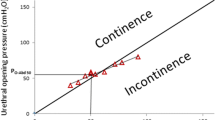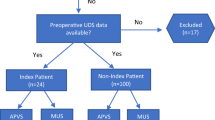Abstract
Introduction and hypothesis
Our goal was to identify correlates of maximum urethral closure pressure (MUCP) and MUCP as a diagnostic test for stress urinary incontinence (SUI).
Methods
This study was a retrospective review of women with non-neurological referrals for urinary incontinence between1995 and 2006.
Results
We studied the characteristics of 8,644 women who underwent urodynamics for non-neurological referrals. Mean MUCP was 48 cm H2O in urodynamic stress incontinence (USI), 50 cm H2O in mixed urinary incontinence (MUI), 65 cm H2O in detrusor overactivity incontinence (DOI) and 67 cm H2O for continent women . Age and MUCP were negatively correlated in all groups. Multiple regression analysis showed lower levels of MUCP in women with USI who also had previous hysterectomy or anti-incontinence surgery or who were in an older age group. Previous anti-incontinence surgery and older age were risk factors for lower MUCP in women with MUI and DOI. Receiver operator curves did not show MUCP to have utility as a diagnostic test despite age and parity stratification. MUCP < 20 cm H2O showed a sensitivity of 5 % and specificity of 98 % in diagnosing USI.
Conclusions
MUCP failed to meet the criteria for a diagnostic test. Women with USI and MUI have lower MUCP than women with DOI and continent women in each decade of life. MUCP decreases with age.



Similar content being viewed by others
References
Weber AM (2001) Is urethral pressure profilometry a useful diagnostic test for stress urinary incontinence? Obstet Gynecol Surv 56:720–735
Edwards L, Malvern J (1974) The urethral pressure profile: theoretical considerations and clinical application. Br J Urol 46:325–335
Lin NY, Yeh NH, Lin CY, Sheu BC, Lin HH (2004) Comparisons of urodynamic characteristics between between female patients with overactive bladder and overactive bladder plus stress incontinence. Urology 64:945–949
Paick JS, Ku JH, Kim SW, Oh SJ, Son H, Shin JW (2004) Tension-free vaginal tape procedure for the treatment of mixed urinary incontinence: significance of maximum urethral closure pressure. J Urol 172:1001–1005
Sand P, Bowen LW, Panganiban R et al (1987) The low pressure urethra as a factor in failed retropubic urethropexy. Obstet Gynecol 69:399–402
Miller JJ, Botros SM, Akl MN, Aschkenazi SO, Beaumont JL, Goldberg RP, Sand PK (2006) Is transobturator tape as effective as tension free vaginal tape in patients with borderline maximum urethral closure pressure? Am J Obstet Gynecol 195:1799–1804
Guerette NL, Bena JF, Davila GW (2008) Transobturator slings for stress incontinence: using urodynamic parameters to predict outcomes. Int Urogynecol J Pelvic Floor Dysfunct 19:97–102
Horbach NS, Ostergard DR (1994) Predicting intrinsic urethral sphincter dysfunction in women with stress urinary incontinence. Obstet Gynecol 84:188–192
Schierlitz L, Dwyer PL, Rosamilia A, Murray C, Thomas E, De Souza A, Lim YN, Hiscock R (2008) Effectiveness of tension free vaginal tape compared with transobturator tape in women with stress urinary incontinence and intrinsic sphincter deficiency: a randomized controlled trial. Obstet Gynecol 112:1253–1261
Abrams P, Blaivas JG, Stanton SL, Andersen JT (1988) The standardization of terminology of lower urinary tract function. The International Continence Society Committee on Standardisation of Terminology. Scand J Urol Nephrol Suppl 114:5–19
Brown M, Wickham JE (1969) The urethral pressure profile. Br J Urol 41:211–217
Osborne J (2002) Notes on the use of data transformations. Pract Assess Res Eval Available via http://ericae.net/pare/getvn.asp?v=8&n=6
Lose G, Griffiths D, Hosker G, Kulseng-Hanssen S, Perucchini D, Schäfer W, Thind P, Versi E (2002) Standardisation of urethral pressure measurement: Report from the standardisation sub-committee of the International Continence Society. Neurourol Urodyn 21:258–260
Hendriksson L, Andersson KE, Ulmsten U (1979) The urethral pressure profiles in continent and incontinent women. Scand J Urol Nephrol 13:5–10
Pfisterer MH, Griffiths DJ, Schaefer W, Resnick NM (2006) The effect of age in lower urinary tract function: a study in women. J Am Geriatr Soc 54:405–412
Murphy M, Culligan PJ, Graham CA, Kubik KM, Heit MH (2004) Is the leak-point pressure alone an accurate predictor of intrinsic sphincter deficiency ? Int Urogynecol J Pelvic Floor Dysfunct 15:294–297
Trowbridge ER, Wei JT, Fenner DE, Ashton-Miller JA, DeLancey JO (2007) Effects of aging on lower urinary tract and pelvic floor function in nulliparous women. Obstet Gynecol 109:715–720
Theofrastous JP, Cundiff GW, Harris RL, Bump RC (1996) The effect of vesical volume on Valsalva leak-point pressures in women with genuine stress incontinence. Obstet Gynecol 87:711–714
Bump RC, Coates KW, Cundiff GW, Harris RL, Weidner AC (1997) Diagnosing intrinsic sphincteric deficiency: comparing urethral pressure, urethral axis, and Valsalva leak point pressures. Am J Obstet Gynecol 177:303–310
Pajoncini C, Constantini E, Guercini F, Bini V, Porena M (2003) Clinical and urodynamic features of intrinsic sphincter deficiency. Neurourol Urodyn 22:264–268
DeLancey JOL, Trowbridge ER, Miller JM, Morgan DM et al (2008) Stress urinary incontinence: relative importance of urethral support and urethral closure pressure. J Urol 179:2286–2290
Schick E, Dupont C, Bertrand PE, Jolivet-Tremblay M, Tessier J (2004) Predictive value of maximum urethral closure pressure, urethral hypermobility and urethral incompetence in the diagnosis of clinically significant female genuine stress incontinence. J Urol 171:1871–1875
Lose G, Brostrøm S (2002) Low-Pressure Urethra in Women: What does it mean and what can it be used for? Int Urogynecol J 13:215–217
Conflicts of interest
None.
Author information
Authors and Affiliations
Corresponding author
Rights and permissions
About this article
Cite this article
Kapoor, D.S., Housami, F., White, P. et al. Maximum urethral closure pressure in women: normative data and evaluation as a diagnostic test. Int Urogynecol J 23, 1613–1618 (2012). https://doi.org/10.1007/s00192-012-1770-7
Received:
Accepted:
Published:
Issue Date:
DOI: https://doi.org/10.1007/s00192-012-1770-7




